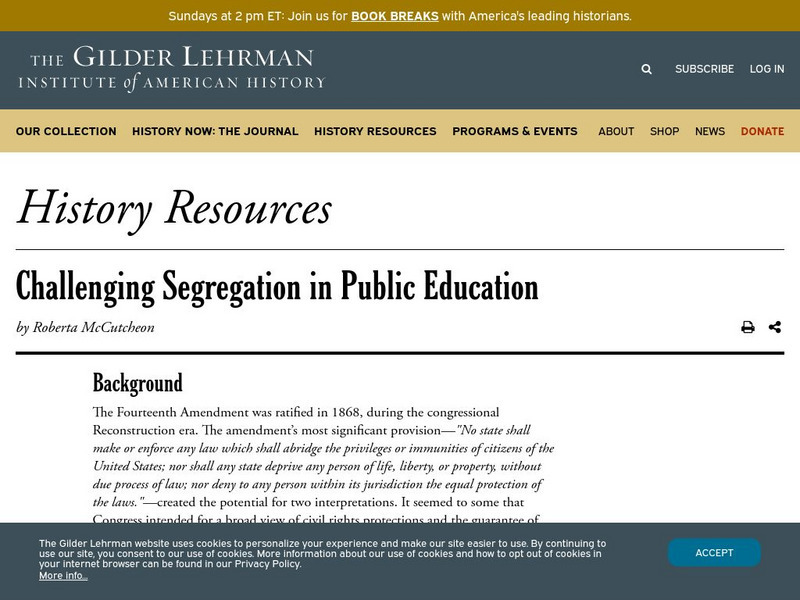Hi, what do you want to do?
Curated OER
Minority Report
Learners examine race relations in Great Britain. In this current events instructional activity, students visit selected websites to understand the impact of immigration on the country as well as multiculturalism in...
Curated OER
Decision Making, Take a Seat or Get off the Bus
Fifth graders explore the positive and negative consequences of choosing to fight against discrimination. They read the story of Rosa Parks. Students discuss the movement against segregation. Students read other books about...
Curated OER
Virginian Contributors
Students examine the contributions of native Virginians to the United States. For each person, they read excerpts of a book about their contributions and organize the information in a chart. In groups, they become an expert on one of...
Curated OER
Investigating the Harlem Renaissance
The work of Langston Hughes opens the door to research into the origin and legacy of the Harlem Renaissance and how the literature of the period can be viewed as a commentary on race relations in America. In addition, groups are assigned...
Curated OER
The Battleground: Separate and Unequal Education
Students investigate the history of unequal education in the United States and the impact on African American history. In this unequal history lesson, students discuss the purpose of education and describe an ideal school. Students...
Curated OER
Brown v. Board of Education of Topeka
Twelfth graders explore desegregation as it occurred at various stages in United States history. They specifically chronicle the role of South Carolina in the desegregation case of Brown v. Board of Education.
Curated OER
Fair Housing and Diversity
Students study the civil rights law of the fair housing act and reinforce learning by playing different intriguing games like Minority Monopoly, which teach diversity adn equality.
Curated OER
Lena Horne: Race and the American Artist
Students examine how race played a critical role in Lena Horne's life. They conduct Internet research, participate in a class debate, write a letter, and create a presentation based on their Internet research.
Curated OER
Martin Luther King, Jr., and the Power of Nonviolence
Students examine the philosophy of nonviolence developed by Martin Luther King, Jr. and how this turned into practice during the Civil Rights Movement. They compare these teachings to those of Mohandas K. Ghandi.
Museum of Tolerance
Making Lemonade: Responding to Oppression in Empowering Ways
An activity focused on tolerance encourages class members to consider how they might respond when they or someone else is the target of oppression and discrimination. After researching how some key figures responded to the...
Curated OER
Celebrating Martin Luther King, Jr. Day
Students honor Dr. Martin Luther King, Jr. and the principles he stood for: justice, equality, freedom, and peace.
Curated OER
The Living Constitution
Tenth graders explore the Constitution as a "living document." After reading three specific cases, learners consider characteristics that make up a living document. In groups, they conduct guided research on each case. Pupils write a...
Curated OER
An Act of Courage, The Arrest Records of Rosa Parks
Students research accounts on Rosa Parks and look for differences between the modern form and an older report on Parks. They discuss why information about race and nationality are collected on these and other forms.
Curated OER
Land Grant Colleges
Students are introduced to the concept of land grant colleges which allowed agriculture to be brought into education. As a class, they create a timeline and compare and contrast the land grant colleges of 1890 and 1892. They use maps...
Curated OER
HEALTH AND BEHAVIORAL STUDIES
Students select a country in South Africa and writes a one-page report on the economic and social issues facing that country, offering suggestions as to how the conditions of poverty and HIV/AIDS.
Curated OER
OK in Oklahoma? All-Black Communities
Students read to discover the African-American migration to Oklahoma following the Civil War and the eventual settlements of thirty-two all-black towns. To present their findings, students will write position papers and participate in...
Curated OER
Before Rosa Parks: Upper Grades Activity: Frances Watkins Harper
Students analyze the rhetorical strategies Frances Watkins Harper used, such as tone, emotional appeal and descriptive language
Curated OER
Gary's Changing Face
Students investigate the history of Gary, Indiana by looking at its history, demographics and points of interest. They create a timeline of important events in the city's history.
Curated OER
Impact of the Progressive Era
Eighth graders examine the impact of the Progressive Era on the state of North Carolina. Using primary source documents, they discover the reason for the creation of schools during this time period. After reading news articles, they...
Curated OER
The Rule of Law
Students continue their exploration of the concept of rule of law. As a class, they discuss how Civil Rights leaders followed the rule of law in their protests. After reading various articles, they participate in a discussion and...
Curated OER
Tobacco: Relationship between Race and Occupation
Eighth graders examine the relationship between race and employment in the tobacco industry. Using the text, they evaluate the impact of polical and economic changes on life in North Carolina. In groups, they research different...
Curated OER
Civics: The Rule of Law
Students examine key concepts pertaining to the rule of law. They explore how Civil Rights leaders such as Martin Luther King, Jr. used it to oppose discrimination practices. They examine Supreme Court decisions demonstrating the...
Curated OER
Suffering and Sunset: An African American Artist's Impression of World War I
Students study paintings by a Pennsylvania artist, Horace Pippin, to explore African-American contributions in World War I. They create presentations based on their impressions of the artwork.
Gilder Lehrman Institute of American History
Gilder Lehrman Institute: Challenging Segregation in Public Education
A senior high lesson plan on segregation in schools.




























